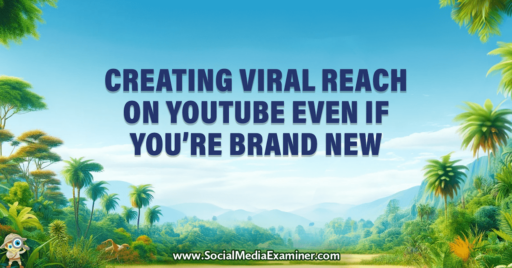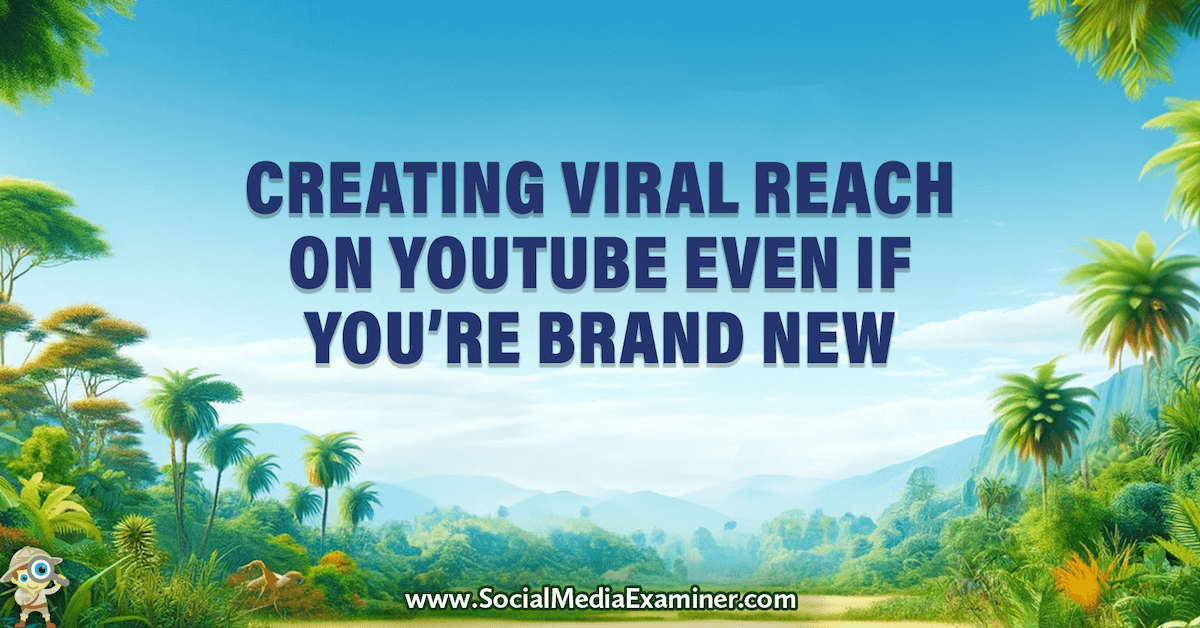Originally Posted on Social Media Examiner by Michael Stelzner
Need to grow substantial YouTube reach? Wondering what’s working in 2024?
In this article, we’ll explore creating viral reach on YouTube.
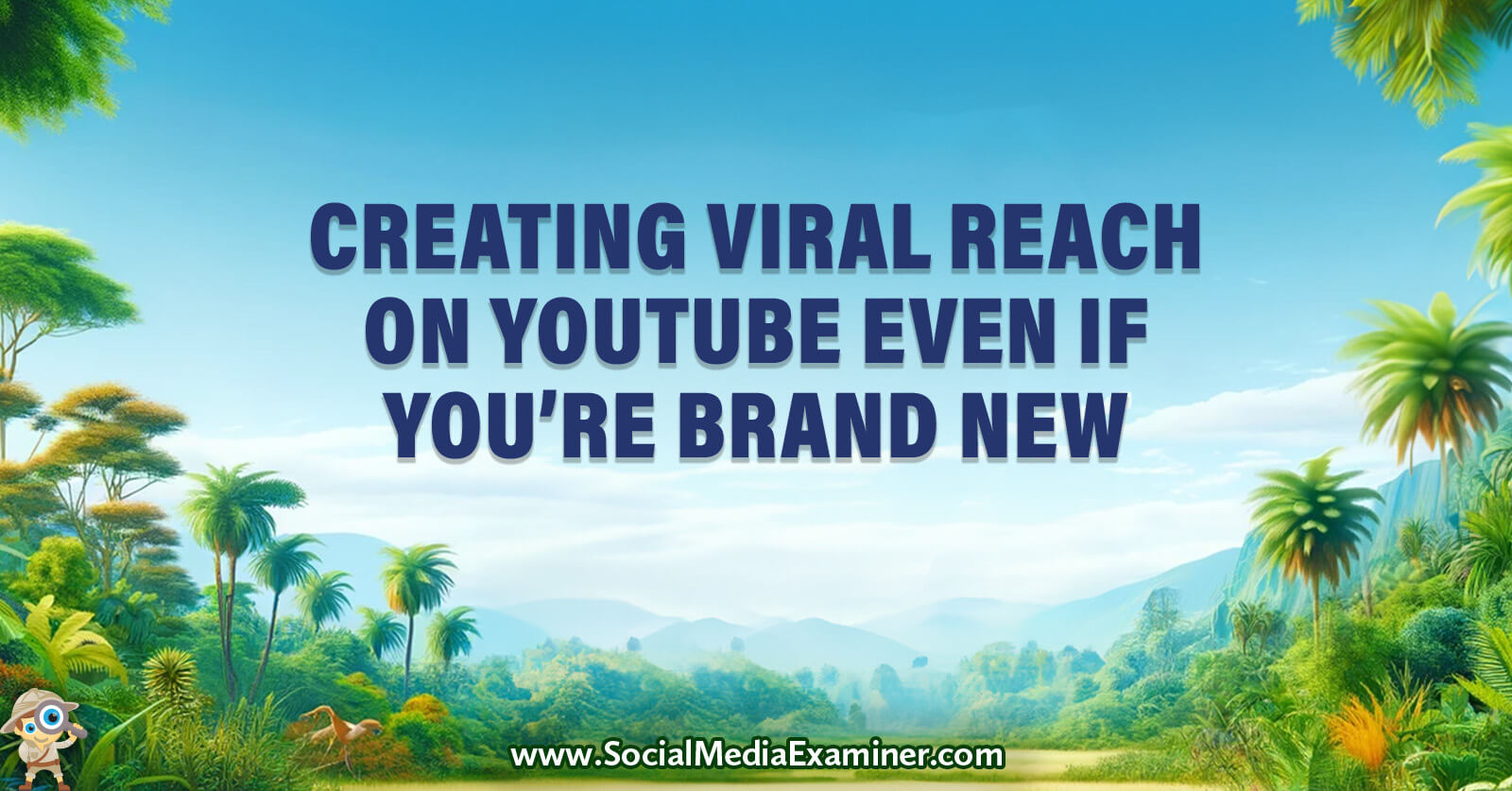
Why Should Marketers Pay Attention to YouTube?
In today’s digital age, YouTube has become an essential platform for businesses, marketers, and content creators looking to expand their reach and engage with their target audience. With over 2 billion monthly active users, YouTube offers vast viral growth and profitability potential. However, navigating the complexities of the platform and understanding the factors contributing to viral success can be challenging.
Liz Germain, founder and CEO of Vidfluence, an organic YouTube growth agency, shares her insights and expertise in helping experts and influencers grow profitable YouTube channels. She illuminates strategies and best practices for achieving viral reach on the platform, even if you’re just starting out.
Liz’s journey to becoming a YouTube expert began with a personal transformation sparked by health challenges, mental well-being struggles, and the loss of a close friend to suicide during her teenage years in Michigan. Determined to create a better life, Liz moved to California, immersed herself in health and fitness, and together with her sister, started a successful blog and online fitness challenges, which led them to recognize the potential of leveraging online platforms to help others on their wellness journeys.
The Power of YouTube for Business Growth
As Liz’s fitness business evolved, she discovered YouTube’s immense potential for driving growth and generating revenue. Despite the platform’s complexity and the initial hesitation to put themselves out there, Liz and her sister recognized that YouTube offered a unique opportunity to reach a wider audience and make a lasting impact.
Liz emphasizes that one of YouTube’s key advantages is its evergreen nature. Unlike timeline-bound social media platforms, YouTube allows content to continue to generate views, leads, and revenue long after publication, even if creators don’t post new videos regularly.
Liz experienced this firsthand with her first YouTube channel, which still covers a significant portion of her overhead expenses despite not posting new content in a year or two. This evergreen quality makes YouTube an attractive platform for businesses and marketers looking to establish a sustainable online presence.
Understanding YouTube’s Algorithms and Traffic Sources
To succeed on YouTube, you must understand how the platform’s algorithms work. Liz explains that the YouTube algorithm is an artificial intelligence (AI) system that operates at the top of multiple segregated algorithms based on traffic sources. These traffic sources include the YouTube Home page, Search, Shorts feed, and Suggested videos, each with its algorithm working cohesively together.
The AI system interprets the relevancy and performance data among these traffic sources, determining which content to recommend to viewers. To grow a YouTube channel, you want YouTube to recommend your content to different ideal audiences. This can be challenging for new YouTubers because they may think the platform’s algorithms are working against them, like being shadow-banned on Facebook.
However, if your content doesn’t perform well in relevance, engagement, and retention in specific traffic sources, YouTube has no reason to show it to wider audiences. The good news is that there are ways to fix this and increase the chances of YouTube’s AI system picking up your content.
How to Create Viral Reach on YouTube: The ‘Grow Method’
Liz has developed a four-step “Grow Method” to help YouTube creators, marketers, and businesses achieve viral reach on YouTube. The method focuses on ensuring that content reaches the right people and performs well in the eyes of YouTube’s AI.
#1: Lay the Groundwork
The first stage of the “Grow Method” involves laying the groundwork for long-term success on YouTube. This includes clarifying your goals and intentions behind creating content on the platform and determining the monetization pathway.
For example, a channel aiming to generate revenue through brand deals, sponsorships, and Google AdSense will have a different programming strategy than one focused on generating leads and sales for a course or program.
Get World-Class Marketing Training — All Year Long!
Are you facing doubt, uncertainty, or overwhelm? The Social Media Marketing Society can help.

Each month, you’ll receive training from trusted marketing experts, covering everything from AI to organic social marketing. When you join, you’ll also get immediate access to:
- A library of 100+ marketing trainings
- A community of like-minded marketers
- Monthly online community meetups
- Relevant news and trends updates
Isn’t it time to get marketing training you can trust?
It’s important to note that YouTube pays creators in the partner program AdSense, an auction-based system that shows ads alongside videos. Even if creators choose not to monetize their content, YouTube will still run ads on their videos. Therefore, Lis recommends that creators keep monetization turned on to offset their operating costs and benefit from the revenue generated by these ads.
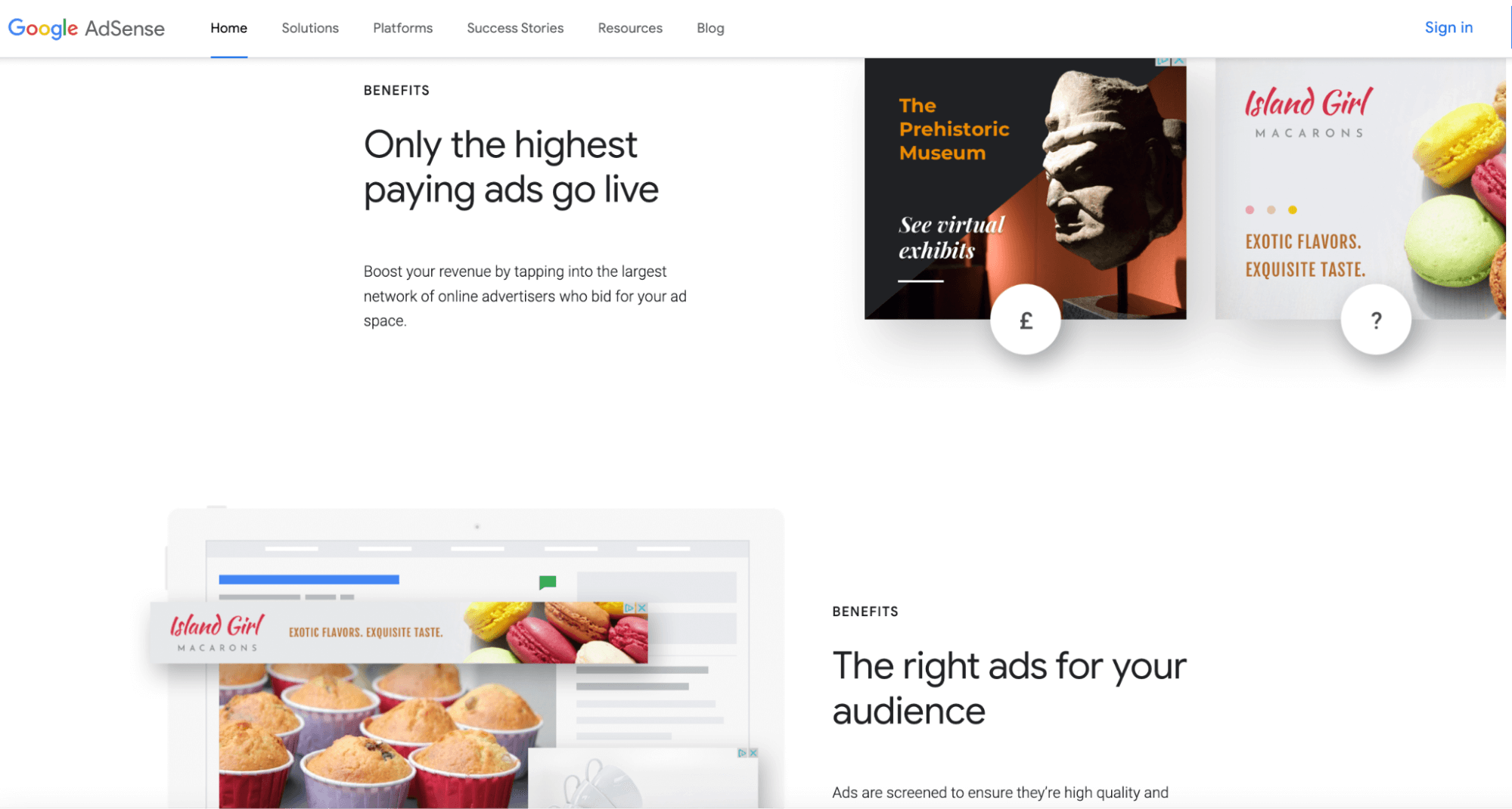
Some business owners may be concerned about competitors running ads on their content. Still, they can manage this by using Google Ads to blacklist or whitelist specific advertising categories or advertisers. It’s important to remember that YouTube wants creators to be good business partners, and since approximately 97% of YouTube’s revenue comes from the AdSense program, aligning with YouTube’s goals is beneficial for creators.
However, AdSense revenue should be considered a “cherry on top” rather than the core monetization strategy for a business behind a YouTube channel. This is because AdSense revenue can fluctuate based on various factors, such as seasonal advertiser campaigns, and creators don’t have direct control over this income stream.
Liz also emphasizes adopting a creator mindset focused on providing value to your audience rather than solely seeking personal gain. People who approach the platform with a “taker mentality,” focusing exclusively on quickly gaining YouTube subscribers, fame, and money, often get frustrated and burn out. Instead, successful creators have a giving mindset and provide value through educational, entertaining, or inspiring content.
#2: Research and Reach
The second stage of Liz’s process focuses on researching and reaching as many people as possible on YouTube. This involves developing a programming strategy and identifying patterns in what your target audience watches most on the platform. By reverse-engineering these patterns and incorporating them into your content strategy, you can effectively maximize your reach on YouTube.
It’s important to understand that not all traffic sources on YouTube are equal. For example, YouTube Search (SEO) accounts for only 7–8% of total daily views on the platform, despite being heavily emphasized in public information. While YouTube Search is great for lead generation and driving sales for niche programs or products, most views come from YouTube recommendations, such as the Home page and Suggested videos.
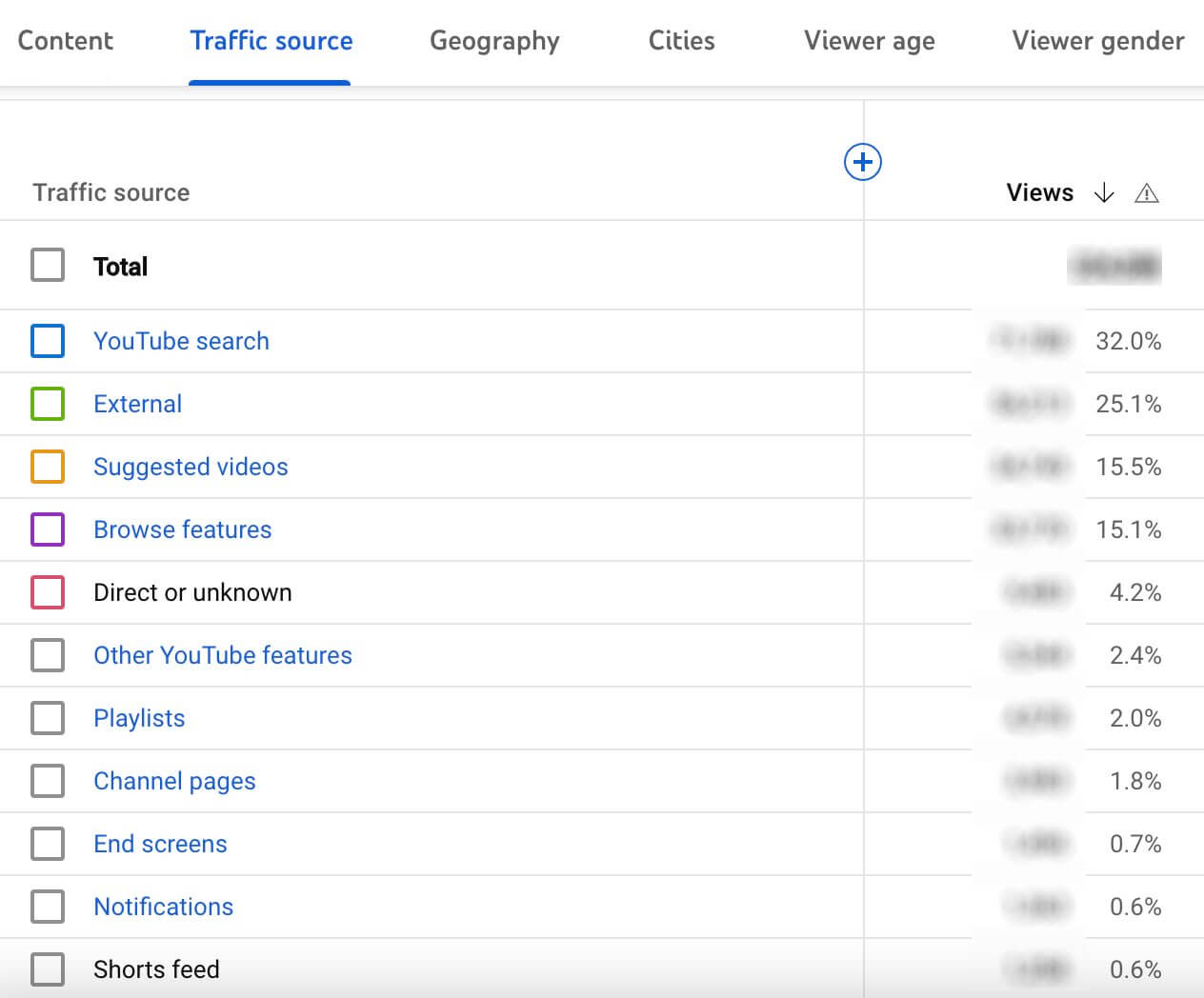
When starting a new channel, you don’t have the analytics data to make informed decisions. Instead, identify the top 10–30 channels in your niche that already own the audience you want to reach on YouTube. Study their programming content strategies and look for patterns in their content. By reverse-engineering these patterns, you can collapse the timeline and avoid making common beginner mistakes.
Look for patterns in:
- Topics: What subjects do they cover in their videos?
- Title structures: How do they format and write their video titles?
- Thumbnails: How are their thumbnails designed and packaged?
- Content and editing: What is their videos’ pacing, style, and format (long-form versus short-form)? Do they use pattern interrupts, talking head videos, storytelling vlogs, or repeating formats?
For example, MrBeast’s channel often repeats the “I survived” format, such as “I survived 30 days in an isolation chamber” or “I buried myself alive for 14 days, and I survived.” This format has proven to be a successful value proposition for his audience.
Another factor to consider is your target audience’s preferences. For example, if your target audience is Gen X or boomers and you’re creating YouTube Shorts daily, you might notice that only one short gets a significant number of views (e.g., 20,000) while the rest perform mediocre. Meanwhile, your long-form videos may only get a couple hundred views. You might wonder why this is happening, especially when everyone recommends creating Shorts and focusing on YouTube SEO.
Gen X and boomers typically spend little time on the YouTube Shorts feed. The Shorts format is more suited to and relevant for younger generations, such as millennials, Gen Z, and the upcoming Gen Alpha.
If you’re in a niche industry with few competitors creating successful content, you can expand your horizons and look for inspiration in tangential verticals. Liz calls this approach the “DJ Khaled method.”
For example, if you’re trying to sell a specific product but can’t find prominent creators in your niche producing entertaining content like MrBeast or Ryan Trahan, consider what else your target audience might be watching on YouTube. Analyze why they like that content and identify the value proposition they’re getting from it.
Ask yourself questions like:
- Why did a particular video go viral?
- What psychological elements encouraged viewers to click and watch from start to finish?
Then, apply what you have learned to your own content strategy, even if the viral video is from a slightly different vertical on YouTube.
It’s important to note that you don’t need to be an entertainer to implement this strategy successfully. By understanding what engages your target audience and adapting those elements to your niche, you can create compelling content that resonates with your viewers.
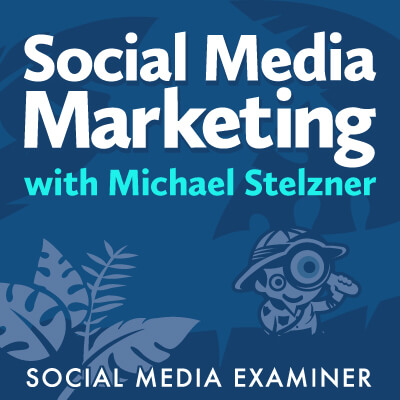
Discover Proven
Marketing Strategies and Tips
Want to go even deeper with your marketing? Check out the Social Media Marketing Podcast! Publishing weekly since 2012, the Social Media Marketing Podcast helps you navigate the constantly changing marketing jungle, with expert interviews from marketing pros.
But don’t let the name fool you. This show is about a lot more than just social media marketing. With over 600 episodes and millions of downloads each year, this show has been a trusted source for marketers for well over a decade.
#3: Test and Optimize Your YouTube Video Content
Once you’ve identified the patterns and elements that make content successful in your niche, create a set of 8–10 test YouTube videos based on your research. These videos should incorporate the title and thumbnail patterns, content topics, and formats that have proven to perform well with your target audience.
When creating your test videos, mix and match the elements you discovered during your research. For example, you might create:
- 2 keyword-based videos
- 3–4 videos using a specific format or title structure that top-performing creator channels repeatedly use
- 1 storytelling video
The goal is to create diverse content that aligns with your audience’s preferences. For example, if your research shows that your audience enjoys podcast-style content, focus on creating videos in that direction rather than vlog-style videos.
By strategically testing a variety of content styles and formats, you increase the likelihood of having 1–2 breakout videos that outperform your typical average. These successful videos will provide valuable insights into what resonates with your audience.
Content production can be time-consuming and expensive, so you must be smart about the content you create and test. By identifying the videos that outperform your channel’s average and doubling down on those formats, styles, and topics, you capitalize on your successes and tap into YouTube’s AI system to gain more impressions and reach a wider audience.
Once you have created and published a series of testing videos based on the insights gained from the research phase, you can optimize your content. This is when you dive into YouTube analytics to analyze your content’s performance and make data-driven decisions to improve your results.
Liz emphasizes the importance of focusing on metrics such as click-through rates, retention rates, and the number of views per viewer. Whether you have an established channel or are brand new on YouTube, this data will guide you in fine-tuning your content strategy for maximum growth.
Click-Through Rate (CTR)
Your CTR measures the percentage of impressions that turn into views. In other words, when your video thumbnail shows up, how often do people actually click to watch? A high CTR means your titles and thumbnails are doing their job of enticing people to click. If it’s low (under 2–3%), it might not be resonating with your broader audience. Try experimenting with more compelling titles, thumbnails, and descriptions to improve your video’s searchability and appeal.

Viral content may experience lower click-through rates over time as YouTube shows them to wider audiences. The longevity of a video’s success can also depend on whether the content is evergreen. If you’re in an industry with evergreen content, your videos can potentially maintain high view counts for an extended period.
Average View Duration
Also known as “watch time,” this metric shows how long viewers stay engaged with your video on average. YouTube wants to promote videos that keep people watching, so the higher your retention, the more your video will be seen by new viewers. Look at where the dips are in your retention curve—are people dropping off at the intro? The midpoint? Use this information to tighten up your storytelling and keep viewers hooked until the end.
Audience Retention
Going hand-in-hand with average view duration, audience retention measures what percent of viewers are still watching at every moment of your video. Ideally, you want a steady retention curve throughout the video’s length. If you see sharp drop-offs, scrutinize those sections and think about what might be causing people to click away. Is there an awkward transition? A dull or repetitive part? A chance to re-engage the viewer with a pattern interrupt or change of pace?
YouTube’s AI aims to predict what viewers want to see and retain them on the platform for as long as possible. To align with this goal, create videos that generate high retention and watch time across your entire channel, not just on a per-video basis.
Views Per Viewer
The key to growing a devoted subscriber base is getting viewers to keep watching more of your content. Check your stats on views per viewer—how many videos do people watch from your channel after clicking on your initial video? Do people tend to watch just one video and then bounce, or do they stick around to watch two, three, or more videos per session?
If your views per viewer are low, you may need to work on creating more groups of related binge-worthy content and optimizing your end screens and playlists to boost your chances of pulling viewers into that next video.
Ongoing Analysis
The goal is to look at these metrics and synthesize them into an overall understanding of how your channel is performing. Some additional tips:
- Check your analytics frequently, but don’t obsess over every little dip or fluctuation. Focus on the macro trends over weeks and months, not days.
- Whenever you upload a new video, check back on the stats after a day or two and note what’s working. Look for any positive or negative patterns across your last 10 videos.
- Once a quarter, do a deep dive and analyze your data from the past 90 days. How does it compare to the previous period? Has your average view duration gone up? Your CTR? Your views per viewer? Celebrate your successes and also pinpoint areas for improvement next quarter.
Remember, YouTube is an algorithm designed to mimic human preferences. Ultimately, the videos that perform best are the ones that viewers find genuinely interesting or exciting and want to keep watching.
YouTube provides some of the most comprehensive analytics of any social media platform. By understanding and utilizing these analytics and continually refining your approach, you can identify what works best for your audience and channel, increase the likelihood that YouTube’s AI will recommend your content, and improve your impressions.
#4: Create a Workflow for Systems and Processes
The fourth stage of the “Grow Method” focuses on helping you sustain your success on YouTube in the long run. As your channel grows, content production becomes more complex and time-consuming, often requiring the support of a team, including video editors, graphic designers, and channel managers.
It’s crucial to have systems and processes in place to ensure a smooth and sustainable workflow. These standard operating procedures (SOPs) help keep everyone on the team in sync, prevent scope creep, and minimize wasted resources. Liz’s agency, Vidfluence, works with prominent creators like Tony Robbins, JJ Virgin, and Chalene Johnson, managing teams of up to 100 people. Without organized production schedules and streamlined SOPs, things can quickly fall apart or become overwhelming.
For those just starting out on YouTube or working with a small team, here are some essential workflow tips:
- Batch film content: Block out 1–2 days every month for YouTube filming, aiming to record 4–5 videos at a time. If you are filming videos with guests, it can be challenging to batch record, but aim to plan your content a month in advance, using analytical research to determine what works and what doesn’t.
- Assign key roles: As your channel grows, you’ll need a thumbnail designer, a video editor, and a channel manager to handle scheduling, uploading, and audience engagement. You may have to take on all these roles yourself when you’re new.
- Use tools and software: Various tools, such as Airtable, Asana, and ClickUp, can help you stay organized and manage your content production more efficiently.
When you commit to a regular filming schedule, assign key roles, and use the right tools, you can create a sustainable workflow that supports your YouTube channel’s long-term growth and success.
By laying the groundwork, conducting thorough research into your reach, optimizing your YouTube videos based on data, and establishing efficient workflows, you can tap into the immense potential of YouTube to grow your brand, engage with your audience, generate sustainable revenue, and unlock the door to viral reach on YouTube.
Liz Germain is a YouTube growth expert. She’s founder and CEO of Vidfluence, an organic YouTube growth agency that helps experts and influencers grow profitable YouTube channels. Her group training and mastermind program is called Channel Amplifier. You can find her on YouTube.
Other Notes From This Episode
Where to subscribe: Apple Podcasts | Google Podcasts | Spotify | YouTube Music | YouTube | Amazon Music |
✋🏽 If you enjoyed this episode of the Social Media Marketing podcast, please head over to Apple Podcasts, leave a rating, write a review, and subscribe.
Stay Up-to-Date: Get New Marketing Articles Delivered to You!
Don’t miss out on upcoming social media marketing insights and strategies! Sign up to receive notifications when we publish new articles on Social Media Examiner. Our expertly crafted content will help you stay ahead of the curve and drive results for your business. Click the link below to sign up now and receive our annual report!
Attention Agency Owners, Brand Marketers, and Consultants

Introducing the Marketing Agency Show–our newest podcast designed to explore the struggles of agency marketers.
Join show host and agency owner, Brooke Sellas, as she interviews agency marketers and digs deep into their biggest challenges. Explore topics like navigating rough economic times, leveraging AI, service diversification, client acquisition, and much more.
Just pull up your favorite podcast app, search for Marketing Agency Show and start listening. Or click the button below for more information.


